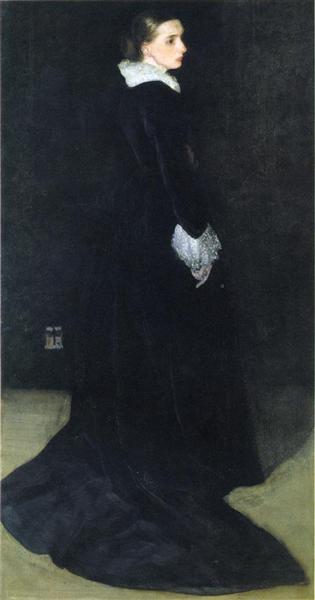Description
James McNeill Whistler, renowned American artist of the nineteenth century, is known for its exploration of tone and color, applying principles that avoid explicit narrative in their works, instead highlighting the atmosphere and composition. "Black arrangement - No. 2 Portrait of Mrs. Louis Huth - 1873" is an exquisite manifestation of these principles.
When observing the work, one immerses himself in the elegance of Mrs. Louis Huth, whose countenance is serene but at the same time enigmatic. The predominant use of black in various textures and tones gives the painting with a depth and an almost ethereal elegance, which transcends mere representation and becomes an exploration of the form and atmosphere. The figure of Mrs. Huth poses with a worthy bearing and the fixed look, projecting an introspective stillness that invites a prolonged observation.
Whistler achieves a masterful integration of his arrangement theory in this work, where the portrait does not intend to be a simple reflection of reality, but a harmonious composition where each element, from the dark costume to the subtle background in black, is conjugated As part of an elder. Its interest in symmetry and proportion is evident, which are reflected in the airy posture and the balanced disposal of the pictorial elements.
The dark background and the almost monochromatic use of color are balanced by the folds of the black dress, which Whistler yields with exquisite softness, providing them with a tangible three -dimensionality. This focus on details demonstrates its ability to handle oil on canvas exceptionally. The brushstroke is both controlled and fluid, creating a sensory combination that mixes both the delicacy of the fleeting and the precise solution of the finish.
Another notable characteristic of the work is the use of negative space. The dark area that frames Mrs. Huth not only reinforces her figure, but also serves to highlight the nuances in her dress and the clarity of her face. Here the influence of the Japanese Ukiyo-E, an art with which Whistler had a great affinity and that applied subtle but shocking his western compositions.
In terms of context, this painting is inserted in Whistler's maturity period, when its style evolved towards greater abstraction and symbolic synthesis. Made in 1873, the painting It coincides with a phase where the artist began experimenting with nomenclatures that emphasized the musical character of his works, using terms such as arrangement, symphony and nocturnal. These titles not only denote the compositional structure, but also their aspiration to create a pure painting, independent of literal narrative.
Whistler's painting, in its entirety, pursues beauty and proportion beyond ordinary representation, and "black arrangement - No. 2 portrait of Mrs. Louis Huth" is a glowing example of this search. In this work, each black nuance becomes a vehicle to express the relationship between the subject and its atmosphere, demonstrating that, under the hand of a master As Whistler, black is not an absence of color, but a presence rich in meaning and emotion.
This portrait not only captures the image of a particular woman, but also encapsulates the aesthetic sensitivity of an era in transition, reflecting the complexity of identity and representation in art. It is a tribute to subtle refinement and technical sophistication that, combined, raises Whistler at the heights of modern art.
KUADROS ©, a famous paint on your wall.
Hand-made oil painting reproductions, with the quality of professional artists and the distinctive seal of KUADROS ©.
Art reproduction service with satisfaction guarantee. If you are not completely satisfied with the replica of your painting, we refund your money 100%.

